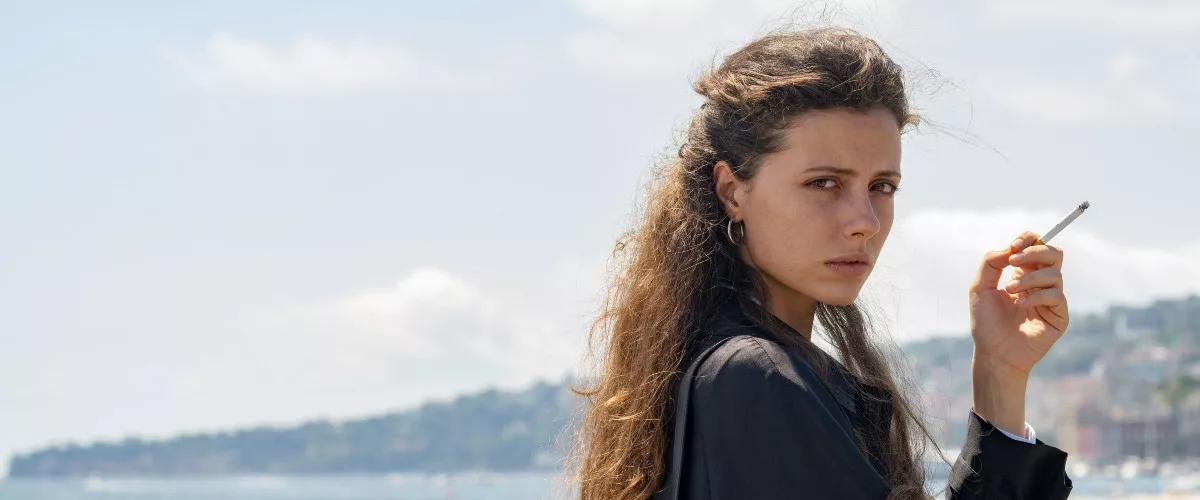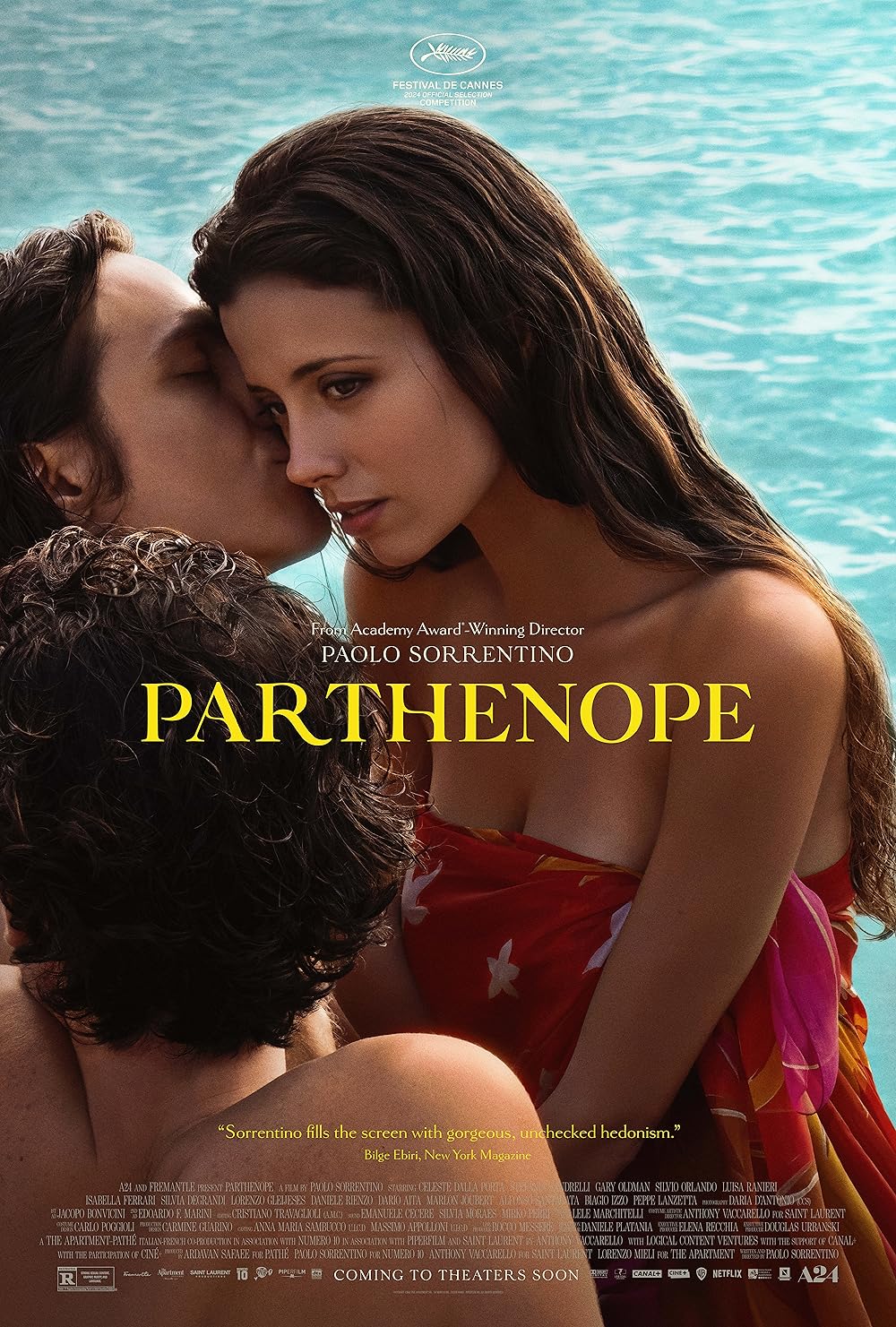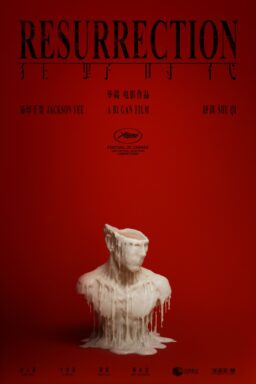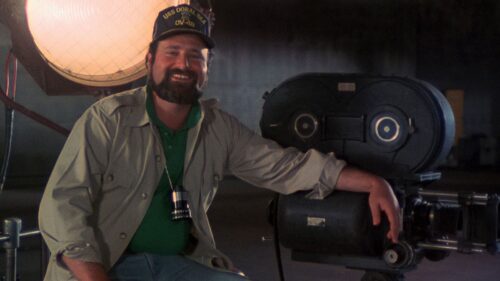Born in the waters off the coast of Naples, the 18-year-old Parthenope is first seen as she emerges dripping from the sea, smoking a cigarette, leaving a male suitor entranced. Named for a siren of Greek myth and the ancient name of her birthplace, this clearly statuesque and intellectually insatiable young woman (Celeste Dalla Porta, ambrosial in her first film role) has recently grown aware of the “disruption” her beauty causes, as one character puts it, but knows not yet how to harness its power for her own purposes—nor what those greater ambitions even are.
Such is the lingering mystery of “Parthenope,” Paolo Sorrentino’s latest meditation on youth, beauty, freedom, and the ephemeral nature of all three, and his first to foreground a female character in questioning what deeper meaning and fulfillment can be found in a life so often informed by external realities.
“Beauty is like war: it opens doors,” Parthenope is told by one character—the middle-aged American writer, John Cheever (Gary Oldman), among the few men she encounters not to be overtaken by lust at the sight of her. Cheever’s loneliness, born of alcoholism and self-loathing over his repressed homosexuality, has much to do with this, but he puts it to her another way: “I don’t want to steal one minute of your youth from you.”
By his logic, she’s a conquering force. Parthenope seems to find the argument persuasive, but many of the doors that her beauty opens lead not to freedom but to its opposite: to suitors who attempt to claim her, tragedies that promise to haunt her, and existential questions that loom ever greater as she ages. “I was sad and frivolous, determined and listless,” she confesses at one point, reflecting on her adolescence. “Like Naples, where there is room for everything, I was alive and alone.”
It’s not the only instance in which Parthenope embodies the essence of Naples, a city that Sorrentino imagines full of contradiction and desire, in thrall to mythology and modernity, caught between self-expression and social expectation.
Sorrentino’s previously best-known works—like “The Great Beauty,” his magnum opus of decay in decadence, and ornately absurd HBO series “The Young Pope” and “The New Pope,” its successor—saw spiritual emptiness beneath the eternal city’s extravagant surfaces. In shifting his focus from Rome to Naples, the birthplace his cinema only recently returned to with the semi-autobiographical “The Hand of God,” Sorrentino’s gaze has softened and become more nakedly nostalgic. There and in “Parthenope,” he idealizes the exuberantly sun-drenched languor of lost youth, even as his characters reckon with more introspective adulthood drawing near—and how this complicates their sense of self.
“It’s impossible to be happy in the most beautiful place in the world,” reflects Parthenope’s brother, Raimondo (Daniele Rienzo). He speaks not only of their city’s winding streets, ornate palaces, and shimmering seaside but also of his growing restlessness in the face of his sister’s affections for both him and Sandrino (Dario Atia), a local who introduces Parthenope to the foolhardy passions of young love.
Sorrentino is less interested in this quasi-incestuous love triangle, which forms early on, than in how its fallout propels her through a picaresque progression of misadventures. Following one overriding impulse at a time through the subsequent decades, Parthenope contemplates a career as an actress before meeting two older women (Isabella Ferrari and Luisa Ranieri) who urge her to find another path. Ultimately, she’s drawn to academia, where a world-weary anthropology professor (Silvio Orlando) instructs her to investigate “the cultural frontiers of the miraculous.” This expression—like many others in this alternately poetic and portentous screenplay—elucidates Sorrentino’s aims as an artist more directly than is perhaps advisable.
Sorrentino’s extravagant portraits have been openly inspired by those of great Italian maestro Federico Fellini, particularly by his lifelong embrace of the sacred and profane. If “The Great Beauty” was comparable to “La Dolce Vita” in its disillusioned unraveling of Rome’s grandeur, “Youth” channeled the existential-artistic conflict of “8 ½,” and “The Hand of God” reflected both “Amarcord” and “I Vitelloni” in its anguished reminiscence, “Parthenope” bears more similarities to Fellini’s “City of Women.” In its highly symbolic study of womanhood in cinema—of dreamlike images of femininity and their inherent distance from reality—that film also intertwined memory and fantasy to hail the ineffable power of the female form while confronting the limits of the male gaze.
Made in collaboration with Yves Saint Laurent, “Parthenope” is nothing if not a sumptuous feast for the senses. Its characters cavort in the gold glow of an endless summer, exquisitely draped in silk and satin finery, dancing between land and sea. In league with cinematographer Daria D’Antonio, whose supple and seductive lensing makes the film a consistent visual pleasure, Sorrentino turns toward a more self-indulgent romanticism than even his previous films had heralded. In showing us a woman’s love affair with a world that worships but also abstracts and eludes her, “Parthenope” reflects a filmmaker unapologetically fascinated by that which he finds most inscrutable. Dalla Porta, her expressive features constantly centered in his frame, is a suitably mesmerizing central figure, an ocean current of emotions rising with a glance.
Across his opulent portraits of people and places, Paolo Sorrentino’s greatest subject has been not beauty or youth but the fleeting dream of freedom that both represent. How intoxicating it can be to discover one’s life as full of enigmas and possibilities, as we do when we’re young, and how melancholic it can be to reflect on the experience and find it limned out by loneliness and regret. The degree to which we can fully see ourselves and the limits of perception in how we see others is another point of fascination. “Desire is a mystery, and sex is its funeral,” remarks Parthenope at one point. But longing for her beauty to remain closed off to others—a vision to be admired, not a spectacle to be consumed—leaves her as alienated from the human experience as the timeless deities to which she’s compared.
Sorrentino never quite illuminates what lies beneath the exquisite surfaces of his character; indeed, “What is she thinking?” is a question pondered by many characters in Parthenope’s orbit, and it’s not one she appears willing or able to articulate, at least to men. What’s not exposed to the audience is also seemingly unknowable—or at least unresolved—to this protagonist. For Parthenope, understanding comes more as accepting her innermost desire for a lifelong romance with emotion, imagination, and the unknown than it does as any secure revelation of self-knowledge.
That the inner workings of women remain a great mystery to Sorrentino will surprise nobody familiar with his past films, which approached them with oneiric awe and eroticism. But with “Parthenope,” he’s fashioned an often transcendently alluring ode to letting the mystery be. Seeking freedom above all else in every facet of her existence, Parthenope escapes definition as a consequence, rendering the film a kind of modern myth of beauty incarnate—striking, seductive, and forever out of reach.




















